Casey Hokanson, BA, Zeinab Mohamud, BA, Janna Gewirtz O’Brien, MD, MPH
In Minnesota, nearly 6,000 youth experience homelessness each night. Trauma and marginalization are often causes of homelessness. Many have been harmed by systemic racism and identity-based oppression leading to stark disparities in the composition of youth experiencing homelessness (YEH) in Minnesota. 73% identify as BIPOC and 23% identify as LGBTQ+. Marginalization and oppression lead to health risks including trauma, injury, abuse, mental health risk, STIs, unplanned pregnancy, untreated medical conditions, substance use, and inadequate access to basic needs including housing, food, and healthcare access. Despite the many challenges YEH face, they display remarkable and inspiring resilience.
We would like to preface by emphasizing that housing is health. It is important for YEH’s basic needs to be met first before they access health. If you come into contact with a YEH who needs shelter, you can help them by bringing ysnmn.org to their attention. This resource that allows YEH to know which resources and shelters are in the community also comes as an app for easier access.
In our lab’s youth participatory action research, YEH identified barriers to navigating complex health systems. We offer some tips on how to overcome these barriers. Remember, although youth experiencing homelessness have a legal right to consent to their own healthcare, even as minors, when they are living apart from their legal guardian(s) and managing their own financial affairs, youth face many challenges accessing care. The last barrier encompasses supporting youth in owning their own healthcare.
How can you as a healthcare provider do this?
- Help them know their own medical conditions, medications, and allergies (use their phones, devices, or Health apps).
- Encourage them to take pictures of their health insurance cards and vital documents so they have easier access to them.
- Share employment opportunities, education and healthcare.
- Know their healthcare team and how to reach them.
- Ensure they have MyChart/electronic health record access.
- Encourage regular checkups. Set up a follow-up before they leave the office or hospital.
- Write down any questions or concerns they have between visits.
- Help them understand their legal rights to accessing healthcare and shelter.

As a healthcare provider, you are a leader in dismantling health inequities and forging positive relationships with youth. It takes a trauma-informed approach, cultural humility, and gentle patience to rebuild this bridge and trust between healthcare providers and youth experiencing homelessness.
